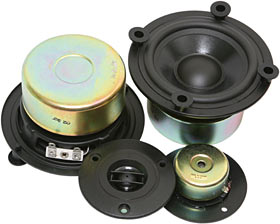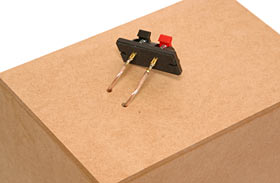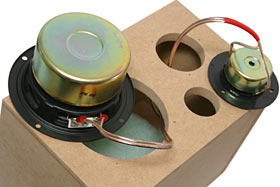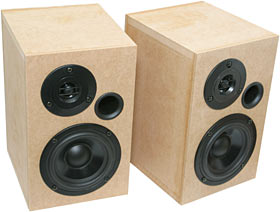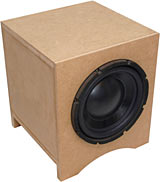
The Loud Speaker Kit M4 Mini Monitors
Review date: 8 November 2002.Last modified 22-Feb-2013.
Most of the world's speakers are rubbish.
The reason for this is simple enough. Rubbish sells.
See, it's easy to make a good-sounding speaker. It's really difficult to make an amazing, fabulous, superlative-sounding speaker, especially if you want it to cost less than a car. But making speakers that just give you a less-than-awful rendition of the sound you're feeding them is easy.
You don't need to use expensive drivers, for a start. The drivers are the actual electromechanical things, usually round, that sit in holes in the speaker box and turn electricity into sound. The sky's the limit for driver prices at the money-is-no-object audiophile end of the market, but you can make a good-sounding pair of speakers using just a couple of cheap six-by-nine-inch paper-cone paper-suspension drivers meant for a 1983 Toyota.
There are hard frequency response and fidelity limits that're put on a speaker by its drivers; the abovementioned six-by-nines won't have fabulous treble response, or a lot of bass, and they'll have a fair few linearity and phase response issues as well. There are also limits imposed by the crossover components in normal multi-driver speakers. Crossovers are the electronics inside the box feeds the right frequency range to the right driver - tweeters don't like bass.
But the vast majority of the speakers in the world are lousy not because of the drivers, or the crossover, or the electronics feeding them the music, for that matter. They're lousy because their general design, and their cabinets in particular, are lousy.
Good cabinets cost money to make. They have to be non-resonant - which means they need to be made out of something pretty solid, and internally braced if they're bigger than bookshelf speakers. And if they use a port for better bass response, then the cabinet and port have to be quite closely matched to the bass driver.
There's nothing very difficult about all this, technically. The design rules for your basic rectangular-box speaker system have been known for ages, and the cabinet-making involved isn't tricky. Manufacturers who make proper boxes do have to use drivers whose manufacturers have reasonable quality control, to make sure that every set of drivers fits every cabinet and crossover the same way, but that requirement only rules out the real bargain basement brigade.
The problem is purely economic.
If you're making speakers for the mass market - which, these days, probably means you're making the speakers that come with some little mini- or midi-system - and you give those speakers cabinets that're acoustically awful but look swish, then you'll sell X many units.
Now, you can probably make good cabinets that look boring and/or ugly for not a lot more money, but you won't sell too many of those. Your good cabs will have to look as nice as the crummy ones, if you want shoppers to even consider purchasing. So they'll be considerably more expensive. And if the system ends up 50% more expensive as a result, you won't sell 2/3X units. So you won't make as much money. People buy cheap stereos, not good stereos.
Mini and midi systems are getting better. It's still easy to find one-package "hi-fi" systems with disastrously awful speakers, but a lot of the little tiddlers on the shelves today have pretty solidly cabineted, though generally tiny, speakers. The cheapest mini systems still come with awful speakers, and there's a whole sub-category of multi-drivered multi-ported ultra-bass-boosted monstrosities whose main reason for existing is to give a superficial impression of good bass response, and everything else can go hang. But if you avoid the bargain basement and Designed By The House Of Lord Vader products, there are some half-decent options to be found.
But if you've only got a couple of hundred Australian dollars (about $US113, as I write this) to spend on a set of speakers, you are not going to be able to afford one of those half-decent options.
Instead, you're going to get, to use a technical term, a speaker-shaped pile of snot.
If you want a couple of water-resistant speakers to put near the barbecue and your sonic requirements stop at "I would like them to be able to make a noise", then you can find OK products below the hundred-Aussie-dollar mark. Similarly, if you just want something goofy looking, you can start with a pair of awful little powered computer speakers, and decorate to taste.
If they were sold separately, the speakers on lots of cheap mini-systems would be below a hundred bucks per pair, but they aren't. And cheap mini-system speakers are still generally, as mentioned above, trash.
If you want something decent for this kind of money, it's just not going to happen. Unless you do one of two things.
One - buy second hand. Lots of people unload old speakers for cheap, and some of those speakers are great.
If you buy second hand speakers that are vinyl-panelled hessian-fronted relics of the '70s, they'll probably have rotten roll surrounds on their drivers, but those can be repaired. Newer used speakers are often perfectly fine as is, and quite young bookshelf speakers from quality manufacturers can be had very pleasingly cheaply, if you hunt around. If you can tell the difference between a proper solid-boxed speaker with decent drivers and some awful chain-store particle-board Masonite-backed wonder, then garage sales, classified ads and auction sites can be great bargain sources.
If you value your time a bit more highly than that, though, then you can take option two. Build a kit.
Good speaker cabinets cost money, you see, partly because of the materials, and partly because of the assembly and finishing. Speaker kits give you the parts and leave the second two tasks to you, but all you typically need to build them is a few spare hours (at most), some glue and a screwdriver, plus whatever paint or carpet or whatever you want to put on the outside, if you can be bothered.
A good speaker kit will give you sound as good as built speakers that cost twice as much as the kit, if not more. And the amount of effort you need to put in is, for decent kits, very low.
Here in Australia, there's a company called The Loud Speaker Kit, who apparently spend their time making speaker kits, not coming up with clever business names.
[UPDATE: As of 2012, The Loud Speaker Kit were out of business; as of early 2013 they're back under new management, though not with a full line of products yet. There are several other kit-speaker companies both here in Australia and overseas. It can also be easier than you'd think to design your own speakers from scratch!]
They've got a selection of kits for stereo and home theatre applications, and they sent me the cheapest one.
This is the M4 Shielded Mini Monitor Kit. This is two speakers worth, and costs $AUD198 plus shipping; you can buy individual Mini Monitors if you like, so you can buy five to make a surround system, or one as a centre channel speaker, or whatever. The Loud Speaker Kit deliver to anywhere in Australia; ground shipping for their kits to various Australian destinations is quite cheap.
For your $198 plus shipping, you get everything you need to make a couple of little two way bookshelf/monitor speakers, but not everything you need to make them pretty. The panels are made of medium density fibreboard (MDF) with a smooth, clean surface, so you can leave them bare if you like; if you want them painted or veneered or otherwise decorated, though, you'll have to provide the finishing supplies yourself. The Loud Speaker Kit recommend you paint the speakers if you live somewhere humid, as MDF will eventually swell up if it's not protected from moisture.
Assuming you don't want some fancy finish or other, building the M4s is very simple. As is usual for speaker kits, it helps to have a couple of tools beyond the bare minimum PVA-glue-and-screwdriver, but you do not need to be any kind of woodworker.
The Loud Speaker Kit allege that the "JigLock" system they use to make their cabinet panels "ensures a perfect result with no tools every time". Based on my experience with the M4 kit, that seems to be pretty much true. The side, top and bottom panels of the kit slot together with a simple tongue-and-groove arrangement which makes it pretty much impossible to not make a square box; you just put glue on the joining points and slot them together. The front and back panels cap off either end of the box, and have a rebate around their edge which neatly fits the side panels.
The tolerances involved are very fine, by woodworking standards; you have to drop the front and back panels in place evenly, all four edges at once, or they won't fit. This is good, partly because it leaves you with a sharp looking box with no gaps or wonky angles, and partly because it gives you a box with no leaks.
You stick all of the panels together without fasteners; you just use glue. The instructions recommend you clamp the boxes while the glue sets, but you don't need proper clamps; just putting something heavy on top of them will do.
Here's one of the bare boxes. The three holes are for the four inch woofer, the tweeter, and the port. These are front-ported speakers, which is good; some "bookshelf" speakers have a port that points backwards, which means you can't actually put them on a bookshelf, or hard up against a wall. The port mustn't be covered.
The next stage in the assembly process is installation of the wiring, drivers, terminals, lagging and port. The woofer hole is quite big enough to allow access to the interior of the glued-together box.
The drivers. You don't get anything too fancy for this price, but as little magnetically shielded drivers go, these are perfectly nice ones. Unremarkable mylar cone tweeter with efficiency-improving horn-reflector-thingy in front of it; little four inch polypropylene-cone woofer with proper rubber roll surround. They'll do.
The four round things on the edge of each woofer, by the way, are packing material that stops the roll surround being flattened while the driver's in its box. The plugs sit in the woofers' mounting screw holes.
All of the speaker connectors are pre-wired to the crossover, such as it is.
A lot of basic bookshelf speakers have a very simple crossover - a capacitor in series with the tweeter, and that's it. Heck, use a piezo tweeter and you don't even need the cap.
This crossover is of the single-cap type, but there are a couple of five watt resistors in there as well.
The bass driver's fed directly from the input, with no components in the way. Crossovers for woofers filter out high frequencies, because woofers aren't much good at reproducing them, and also because high frequencies heat woofer voice coils up, to no purpose. This little four inch bass driver will do fine without any filtering, though.
Sending bass to practically all kinds of tweeter is much worse than sending treble to a woofer; any significant bass input will cause the tweeter to over-extend and damage itself. Hence, the capacitor.
The M4's tweeter would also appear to be rather more efficient than the bass driver, and so its input needs to be attenuated somewhat; that's what the resistors are for. There's 5.6 ohm resistor in series with the tweeter's positive input, along with the cap. The other resistor, a 3.3 ohm unit, connects the tweeter's positive input directly to the speaker's negative terminal, shunting some of the tweeter's input away.
The rear panel terminal is a standard spring-clip type. It'll accept any ordinary smallish-gauge bare speaker wire. It's rubber-backed so it seals its own wire-holes effectively, and you attach it with two of the provided screws.
Connecting the drivers, according to the instructions, is simply a matter of sliding on the spade-lug terminals. I found that the woofer terminals were very loose, so I had to crimp them down with pliers. The tweeter terminals were a bit jiggly as well, so I crimped them too. If you want a really shakeproof connection you can solder the terminals together, but crimping should be more than adequate.
The tweeter terminals need to be insulated from the magnetic-shielding can on the back of the driver; they ought not to touch it, quite, but it's best to put a piece of tape under them to make sure.
Before you screw the speakers into place, you have to pack the lower portion of the cabinet with the provided green fluffy wadding, which is there to reduce resonance and make the cabinet behave like a slightly larger one, at the expense of a bit of efficiency.
Three of the drivers in this pair of M4s fit easily and lined up perfectly with their screw holes. One of the woofers needed its terminal board bent inward a bit to make it line up right. Installing the ports, in contrast, was trivial; you just press them into the holes. Done.
The finished result. The "mini" part in the M4 Mini Monitors' name is there for a reason; they're only 234mm high by 145mm wide by 167mm deep (9.2 by 5.7 by 6.6 inches).
Despite the couple of minor hiccups mentioned above, the assembly process really is very straightforward, and the instructions (which you can download in PDF format here) are clear.
You don't get grilles for the front of the M4s in the kit, but The Loud Speaker Kit sell short-form grille kits for people who want them. The grille kits contain cloth and clips, but not frames; you have to make the frames yourself.
Listening tests
I hooked up the M4s to the hi-fi amplifier in my living room. Mini monitors are generally meant to be listened to at quite close range, and the M4s are magnetically shielded and could therefore be set up right next to a TV or monitor, but I wanted to see if these little tiddlers could cut it as regular hi-fi speakers.
Yes, they can.
For $AUD200 speakers, these are pretty good. For little tiny speakers, they're very good. For little tiny $AUD200 speakers, they are, if I may be permitted a brief excursion into the vernacular, bloody good.
Which is not to say that these are the best speakers I've ever heard. They don't have elephantine bass or incredible stereo clarity or any of the qualities that hi-fi mags talk about using a variety of bizarre adjectives. But if you're used to the sound quality of a $AU250 mini system, or indeed of a $AU200 set of computer speakers, then the M4s driven by any old amplifier (yours for not much from a garage sale, classifieds paper or auction site...) will be something of a revelation.
The Loudspeaker Kit say that the M4s can handle 50 watts RMS, which is rather respectable for such tiny speakers, but not really important. All things being equal, 50 watts only sounds twice as loud as five watts, which only sounds twice as loud as 0.5 watts. Unless your speakers are very inefficient or you like your music very loud, practically all of your hi-fi listening will be done at only a couple of watts per channel.
Like a lot of small speakers, the M4s aren't amazingly efficient; only 86dB using the standard one-watt-at-one-metre test. That's far from awful, though, and my listening tests demonstrated that you can wind the M4s up to party volume without hearing their poor little voice coils slapping the stops.
The M4s don't get the floor moving, but for their size their bass is excellent. The Loudspeaker Kit quote a -3dB bass response figure of 55Hz for them, which they seem to pretty much achieve. They don't have the huge-hump-in-the-response-curve bass tuning that lots of cheap ported speakers use, so people used to boom-box thump won't be impressed - but if you listen to the M4s for a moment, you'll notice that they can play more than one bass note. Hump-tuned speakers can't.
Overall
If you don't know diddly about speakers - and most people don't, which has been the basis for some successful business ventures - kits like the M4s allow you to get hold of something with some genuine fidelity for the same money that a chain store will charge you for a seriously technically inferior product.
Buying speakers from a place that also sells sofas, rice cookers and underpants is fine, if they sell some particular product that you know all about and just want to walk in, purchase and leave. Otherwise, it's like buying a telescope from the same place.
The difference between a properly designed, solidly made, honest little speaker like an M4 and the crummy speakers that most people buy is not obscure. It is not hard to hear. It is not the stuff of golden-eared woo-woo gullible audiophile psychoacoustic lunacy (which has reached the point where it can be hard to tell whether something's meant as a joke or not).
Provided you've got reasonably functional hearing, you really ought to be able to tell why these things are better. And provided you're not a total klutz, you should be able to put them together.
And they're quite cheap.
And if you've always wanted lime green, hot pink or International Safety Orange speakers, a kit like this is great. Just buy yourself a can or two of spray paint of the appropriate colour and go to town with it before you install the electronics in the box.
If you're not somewhere in Australia (including Tasmania) then The Loud Speaker Kit aren't any use to you; they don't do international orders. There are lots of speaker kit suppliers, though; hunt around where you live and see what you can find.
If you are in Australia, The Loud Speaker Kit's products seem excellent. Their other kits are considerably more expensive than the M4s, but if the M4s are anything to go by, the others should be great value too.
Recommended.
Review kit kindly provided by The Loud Speaker Kit.
[UPDATE: As of 2012, The Loud Speaker Kit were out of business; as of early 2013 they're back under new management, though not with a full line of products yet. There are several other kit-speaker companies both here in Australia and overseas. It can also be easier than you'd think to design your own speakers from scratch!]
Big brother
Say hello to Mr Bass.


